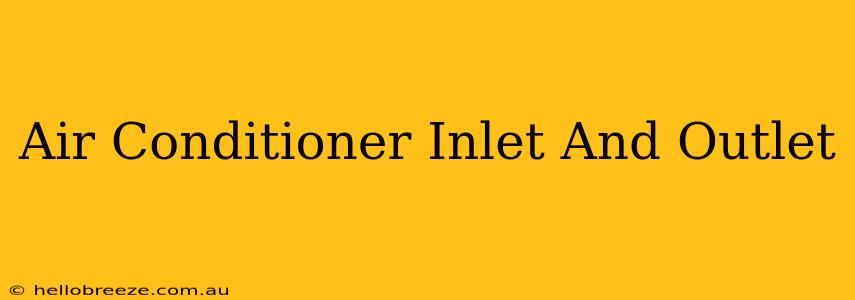Understanding your air conditioner's inlet and outlet is crucial for maximizing its efficiency and ensuring your comfort. This guide will break down the importance of these components, common issues, and how to maintain them for optimal performance.
What are Air Conditioner Inlet and Outlet?
The inlet and outlet are the two critical points in your air conditioner's airflow system. They are responsible for drawing in warm air and expelling cool air, respectively.
-
Inlet: This is where the air conditioner draws in warm air from the room. It's usually located on one side or the bottom of the unit. The air is then filtered and cooled before being released. A clean and unobstructed inlet is crucial for efficient operation.
-
Outlet: This is where the cool air is released back into the room after being processed by the air conditioner. The outlet is typically located on the opposite side or top of the unit from the inlet. The design of the outlet affects the air distribution throughout the space.
The Importance of Proper Airflow
Efficient airflow is paramount for a properly functioning air conditioner. Restricted airflow through either the inlet or outlet can lead to several problems:
-
Reduced Cooling Capacity: If the inlet is blocked, the AC unit has to work harder to pull in sufficient warm air, reducing its overall cooling power. This leads to higher energy consumption and potentially overheating of the unit.
-
Increased Energy Bills: A struggling air conditioner due to airflow issues will consume more energy attempting to reach the desired temperature.
-
Uneven Cooling: A restricted outlet can lead to uneven cooling throughout the room, with some areas remaining warmer than others.
-
Unit Overheating and Damage: Prolonged restricted airflow can cause the compressor and other components to overheat, potentially leading to costly repairs or even complete unit failure.
Common Inlet and Outlet Problems
Several factors can impede proper airflow through your air conditioner's inlet and outlet:
-
Blocked Inlet: Furniture, curtains, rugs, or other obstructions near the inlet can significantly reduce airflow.
-
Dirty Air Filter: A clogged air filter restricts airflow, forcing the unit to work harder. Regular filter cleaning or replacement is essential.
-
Frozen Coils (Outlet Issue): Inadequate airflow can lead to ice formation on the evaporator coils, further hindering airflow. This often stems from a dirty filter or restricted outlet.
-
Restricted Outlet: Similar to the inlet, obstructions near the outlet can impede the release of cool air, affecting cooling efficiency.
Maintaining Optimal Airflow
To ensure your air conditioner runs efficiently and effectively, follow these maintenance tips:
-
Regularly Clean or Replace the Air Filter: Check your filter monthly and replace it as needed, according to the manufacturer's recommendations.
-
Keep the Inlet and Outlet Clear: Ensure there are no obstructions near the inlet and outlet. Maintain adequate clearance around the unit.
-
Inspect for Debris: Regularly inspect the unit for any debris buildup, especially around the coils and fan.
-
Professional Maintenance: Schedule annual professional maintenance to ensure your air conditioner is in optimal condition. A technician can identify and address any potential airflow problems.
By understanding the role of your air conditioner's inlet and outlet and following these maintenance tips, you can ensure optimal cooling, energy efficiency, and prolong the lifespan of your unit. Proper airflow is the key to a cool and comfortable home!

